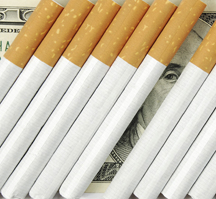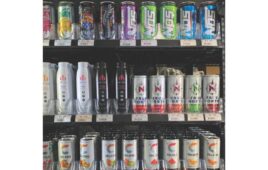 Even as cities and states invoke new legislation, cigarette sales remain steady.
Even as cities and states invoke new legislation, cigarette sales remain steady.
By Anne Baye Ericksen, Contributing Editor
On Election Day this year, voters in North Dakota will decide on who will be the next president and whether to approve a proposed tax hike on cigarettes. Since 1993, the state tax has held at a mere 44 cents per pack, the fifth lowest in the country. The ballot measure proposes to bump it to $2.20 per pack, a 400% increase.
Far away in the Show Me State, Missourians going to the polls on Nov. 8 also face a choice about raising taxes on cigarettes. Currently, its citizens pay the least amount in taxes on cigarettes at 17 cents per pack. Voters have the option of increasing the amount by either 60 cents per pack or only six cents per pack, which would keep Missouri as the least taxed state on cigarette sales. The larger increase would generate funds for early childhood health and education programs.
According to opponents, however, the measure contains language that would increase the tax to $1.27 for smaller tobacco companies that are exempt from the 1998 Master Settlement Agreement, which resulted in the largest tobacco companies conceding to pay annual sums to 46 states to cover healthcare costs associated with smoking. The smaller tax proposal would direct monies toward infrastructure projects.
Smokers in Pennsylvania have been paying $1 more per pack since this past August when a new state’s new tax went into effect. This latest excise was the biggest increase levied against cigarette sales in more than 80 years, and takes the cigarette tax in Pennsylvania from $1.60 a pack up to $2.60 a pack, making it the 10th highest cigarette tax in the nation.
The National Association of Convenience Stores (NACS) reported that at least one Pennsylvania c-store opted to close its doors due to the economic impact the higher tax wielded on its bottom line.
“State lawmakers find taxing cigarettes an easy target because only about 20% of the adult population smokes,” said Thomas Briant, executive director for the National Association of Tobacco Outlets (NATO). “This is an unfair means of taxation to burden a minority of the population to solve a state budget deficit problem.”
AGE MATTERS
In addition to new taxes, there’s been a bevy of motions to raise the minimum age for tobacco purchases. In June, Chicago joined the growing list of cities adopting 21 as the purchase age. In August, Ann Arbor City Council also voted to raise the age, making it the first city in Michigan to make the move. The new ordinance will take effect Jan. 1, 2017.
Other major cities that have aged up are New York, Boston, Cleveland, and Kansas City in both Kansas and Missouri. According to Wells Fargo Securities, more than 155 communities in 11 states have enacted 21 as the minimum age.
California became the second state to make 21 the minimum age for all tobacco purchases; Hawaii was the first. However, several other states are debating the issue, too. New York, Kentucky, Oregon and Illinois legislatures have introduced bills to change the minimum age from 18 to 21. There’s also a Massachusetts bill to raise the legal age that passed the state Senate and awaits a vote in the state House of Representatives.
The reaction to the taxes and age restrictions in the retail environment has been somewhat mixed. In New York state, which carries the highest cigarette tax in the country at $4.35 per pack, c-stores not only compete with other retailers and tobacco outlets, but also with tax-exempt businesses and illegal sales.
“In our market, we are greatly affected by the sale of black-market cigarettes and sales on Indian reservations that are not taxed,” said Peter Tamburro, general manager of convenience store operations for Clifford Fuel Co., in Utica N.Y. The company operates 17 Nice N Easy franchise stores and three full-service gas stations across central New York state.
“Many cartons of cigarettes are sold on the streets at deep discounts or border states,” he added. “Sixty percent of all cigarette sales in New York are black market [or on] Indian reservations.”
Also, when neighboring cities have different age requirements, the result can drive sales out of town. “This is especially true for retailers near a state border where retailers in the next state would enjoy a significant tax advantage and be able to sell cigarettes at much lower prices,” said Briant.
“The irony is that, while local lawmakers claim adopting such restrictions will reduce tobacco use, such a result will not occur because customers simply change where they buy their tobacco products,” he continued. “Local tobacco ordinances cause adult consumers to simply drive a short distance to the next city or town to purchase their preferred tobacco products if they are either not available at their neighborhood store or priced too high due to the local ordinance provisions.”
Plus, when cigarette business drops, it can cast a ripple effect onto other categories. It’s typical for customers to add beverages, snacks, foodservice or tobacco accessories to their purchase totals when buying cigarettes. But if they’re bypassing a store in a high tax zone or with a higher age requirement, then those transactions aren’t transpiring either.
“We deal with smaller market basket sales as cigarette unit sales are half of what they were a decade ago,” said Tamburro. “The cigarette category is at its lowest percentage of overall sales mix. Profit margins and sales in cigarettes have forced New York operators to find other sources of margin, generally in foodservice.”
SALES RISE DESPITE LAW
In the few months since California enacted its 21 minimum age requirement, cigarette sales, on average, still increased at more than 30 retail locations managed by J&T Management, based in Corona, Calif., including 25 ARCO ampm stores, which might be part of a recovering economy.
“We have an increase [in sales] even with changes in taxes, but we do not have enough data yet to see how the change in minimum age will affect the sales,” said Jack Kofdarali, president of J&T Management and chairman of NACS.
So far in 2016, the company has recorded month-after-month sales growth, and not just in tobacco products.
“You would think if you restrict the minimum age required for tobacco purchases, then these potential customers will not visit our locations, therefore the sales of other categories (soft drinks, candies, snacks, etc.) will be affected as well, but that doesn’t seem to be the case thus far. Sales are doing well,” said Kofdarali. “The overall percentage increases are pretty much in line with the increases in tobacco.”
The biggest change he’s instituted is to retrain employees to abide by the law change.
“Also, we now have electronic machines to check on all IDs,” Kofdarali said.
TRENDING ON
While these businesses showcase contrasting reactions to regulations, national data confirms the cigarette segment of the tobacco category remains steady. According to IRI, a Chicago-based market research firm, unit sales of cigarettes in convenience stores for the four weeks ending Aug. 7, 2016 rose 0.56%.
Dollar sales for the four weeks ending Aug. 13 were up more than 1%, according to Nielsen data reported by Wells Fargo Securities. For the 12-week period ending in mid-August, dollar sales rose by 1.5%. However, analysts continue to attribute the growth of dollar sales to ongoing price increases, more than 3% for the aforementioned four-week period.
Regardless of next month’s election outcomes, c-stores have and will need to continue adjusting to tobacco regulations that are sure to come as legislatures resume sessions later this year.




